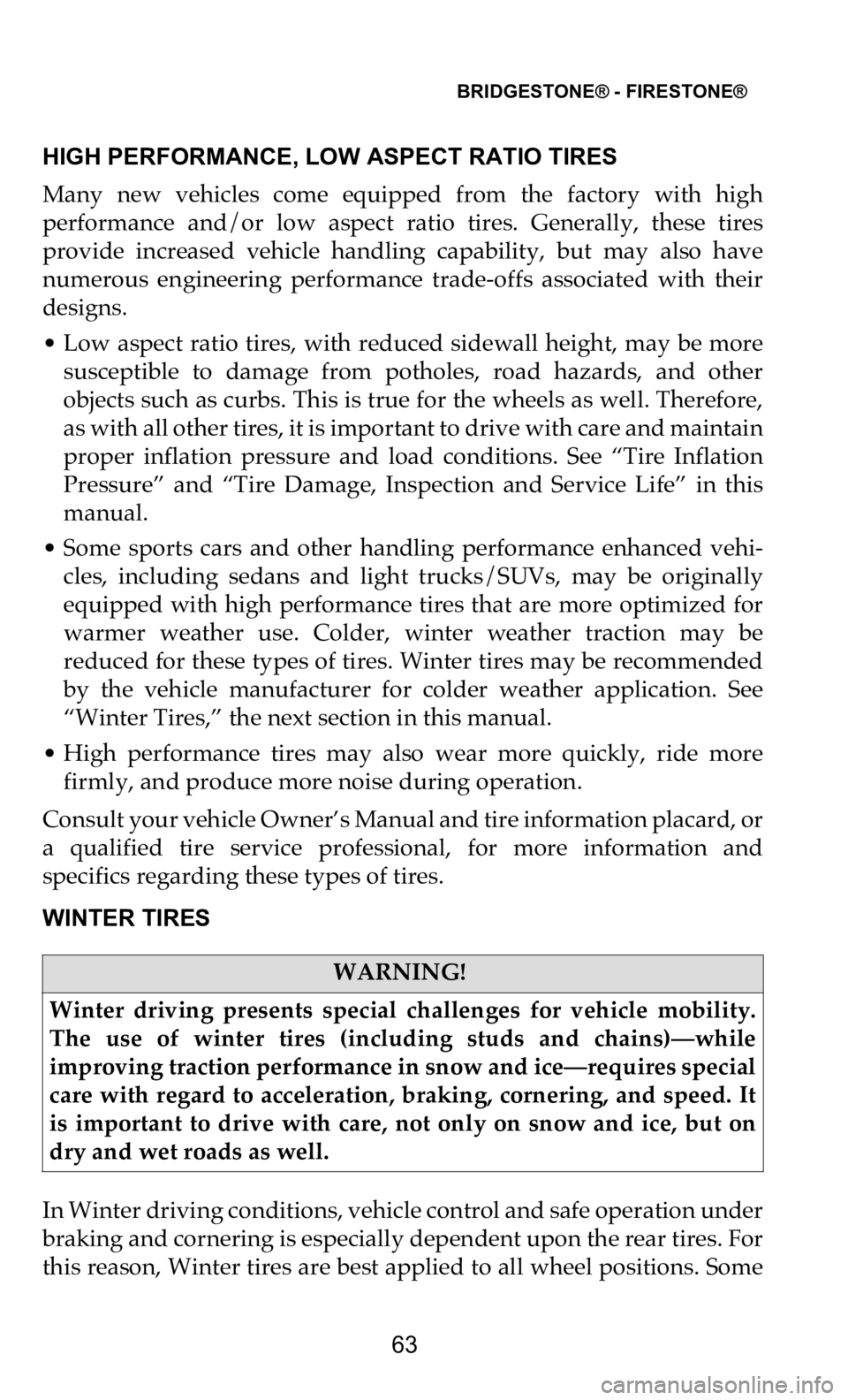light DODGE DURANGO 2021 Vehicle Warranty
[x] Cancel search | Manufacturer: DODGE, Model Year: 2021, Model line: DURANGO, Model: DODGE DURANGO 2021Pages: 262, PDF Size: 10.42 MB
Page 4 of 262

TIRES
3
• LT (Light Truck) — Metric tire sizing is based on US design stan -
dards. The size designation for LT-Metric tires is the same as for
P-
Metric tires except for the letters “LT” that are molded into the
sidewall preceding the size designation. Example: LT235/85R16.
• Temporary spare tires are designed for temporary emergency use
o
nly. Temporary high pressure compact spare tires have the letter
“T” or “S” molded into the sidewall preceding the size designation.
Example: T145/80D18 103M.
• High flotation tire sizing is based on US design standards and it
b
egins with the tire diameter molded into the sidewall. Example:
31x10.5 R15 LT.
Tire Sizing Chart
EXAMPLE:
Example Size Designation: P215/65R15XL 95H, 215/65R15 96H, LT235/85R16C,
T1
45/80D18 103M, 31x10.5 R15 LT
P = Passenger car tire size based on U.S. design standards, or
"....blank...." =
Passenger car tire based on European design standards, or
LT = Light Truck tire based on US design standards, or
T
or S = Temporary spare tire or
3
1 = Overall diameter in inches (in)
2
15, 235, 145 =
Section width in millimeters (mm)
65, 85, 80 = Aspect ratio in percent (%)
•
Ratio of section height to section width of tire, or
1
0.5 = Section width in inches (in)
R
= Construction code
• "R" means radial construction, or
•
"D" means diagonal or bias construction
1
5, 16, 18 = Rim diameter in inches (in)
S
ervice Description:
95 = Load Index
•
A numerical code associated with the maximum load a tire can carry
H
= Speed Symbol
• A symbol indicating the range of speeds at which a tire can carry a load corre -
s
ponding to its load index under certain operating conditions
• The maximum speed corresponding to the speed symbol should only be achieved
u
nder specified operating conditions (i.e., tire pressure, vehicle loading, road condi -
tions, and posted speed limits)
Page 5 of 262

TIRES
4
Tire Identification Number (TIN)
The TIN may be found on one or both sides of the tire; however, the
da
te code may only be on one side. Tires with white sidewalls will
have the full TIN, including the date code, located on the white
sidewall side of the tire. Look for the TIN on the outboard side of black
sidewall tires as mounted on the vehicle. If the TIN is not found on the
outboard side, then you will find it on the inboard side of the tire.
Load Identification:
Absence of the following load identification symbols on the sidewall of the tire
in dicates a Standard Load (SL) tire:
• XL
= Extra load (or reinforced) tire, or
•LL
= Light load tire or
•C, D, E, F, G
= Load range associated with the maximum load a tire can carry at a
specified pressure
Maximum Load –
Maximum load indicates the maximum load this tire is designed to
carry
Maximum Pressure –
Maximum pressure indicates the maximum permissible cold
tire inflation pressure for this tire
EXAMPLE:
DOT MA L9 ABCD 0301
DOT = Department of Transportation
•
This symbol certifies that the tire is in compliance with the US Department of Trans -
p
ortation tire safety standards and is approved for highway use
MA = Code representing the tire manufacturing location (two digits)
L
9 = Code representing the tire size (two digits)
A
BCD = Code used by the tire manufacturer (one to four digits)
0
3 = Number representing the week in which the tire was manufactured (two digits)
•
03
means the 3rd week
01 = Number representing the year in which the tire was manufactured (two digits)
•
01
means the year 2001
• Prior to July 2000, tire manufacturers were only required to have one number to
r
epresent the year in which the tire was manufactured. Example: 031 could repre -
sent the 3rd week of 1981 or 1991
EXAMPLE:
Page 26 of 262

BFGOODRICH® TIRES
25
BFGOODRICH® TIRES
ABOUT THIS WARRANTY
As the original purchaser of a BFGoodrich® brand passenger or light
tr
uck tire, you are covered by all the benefits and conditions (subject
to the maintenance recommendations and safety warnings) contained
in this booklet. To ensure your understanding of and compliance with
the terms and conditions of this warranty, please read it carefully. It is
essential that you also read and understand the safety and
maintenance recommendations for tires contained in this booklet.
WHAT IS COVERED AND FOR HOW LONG
Passenger and Light Truck Tires
BFGoodrich® brand passenger and light truck tires, used in normal
se
rvice on the vehicle on which they were originally fitted and in
accordance with the maintenance recommendations and safety
warnings contained in the attached Owner’s Manual, are covered by
this warranty against defects in workmanship and materials for the
life of the original usable tread, or six years from the date of purchase,
whichever occurs first. At that time, all warranties, express or implied,
expire. The life of the original usable tread is the original tread down
to the level of the tread wear indicators - 2/32 nds of an inch (1.6 mm)
of
tread remaining. Date of purchase is documented by new vehicle
registration or tire sales invoice. If no proof of purchase is available,
coverage will be based on the date of manufacture. Replacement will
be made in accordance with the terms and conditions described under
“How Replacement Charges are Calculated”.
NOTE:
Your vehicle manufacturer may provide additional tire warranty
co
verage over and above what is provided by BFGoodrich®. Consult
your vehicle Owner’s Manual for further information.
WHAT IS NOT COVERED
Tires Which Become Unserviceable Due To:
• Road hazard injury (e.g., a cut, snag, bruise, impact damage or
p
uncture)
• Incorrect mounting of the tire, tire/wheel imbalance or improper
r
epair
Page 27 of 262

BFGOODRICH® TIRES
26
• Misapplication, improper maintenance, racing, underinflation,
overinflation or other abuse
• Operation without a properly functioning low pressure warning
s
ystem, for Comp T/A® ZR SSS tires
• Uneven or rapid wear which is caused by mechanical irregularity in
t
he vehicle such as wheel misalignment, a measured tread differ -
ence of 2/32 nds of an inch (1.6 mm) or more across the tread on the
sa
me tire
• Accident, fire, chemical corrosion, tire alteration or vandalism
•
Flat spotting caused by improper storage or brake lock
•
The adding of liquid, solid or gaseous materials other than air,
n
itrogen or carbon dioxide for example, waterbase sealers or
balancing substances
• Ozone or weather checking
H
OW REPLACEMENT CHARGES ARE CALCULATED
Passenger And Light Truck Tires Workmanship/Materials
A tire which becomes unserviceable due to a condition covered by this
wor
kmanship and materials limited warranty will be replaced with a
comparable new BFGoodrich® brand tire, free of charge, when 2/32 nds
of an inch (1.6 mm) or less of the original tread is worn, (or 25% or less,
whi
chever is more beneficial to you) and within 12 months of the date of
pu
rchase. The cost of mounting and balancing the tire is included. You
pay the cost of any other service charges and applicable taxes.
When more than 2/32 nds of an inch (1.6 mm) of the original tread has
be
en worn (or more than 25%, whichever is more beneficial to you) or
after 12 months from the date of purchase, you must pay the cost of a
co
mparable new BFGoodrich® brand passenger or light truck
replacement tire on a pro rated basis. The retailer shall determine the
charge by multiplying the percentage of the original usable tread
worn by the current selling price at the adjustment location or the
price on the current BFGoodrich® brand Base Price List, whichever is
lower. This list is based on a predetermined price intended to fairly
represent the actual selling price of the tire.
You pay the cost of mounting, balancing, and or any other service
ch
arges and applicable taxes.
Page 33 of 262

BFGOODRICH® TIRES
32
SPEED RATINGS
Speed Symbols are shown on the sidewall of some BFGoodrich® tires.
Th
e following table shows the maximum speed corresponding to the
symbol.
*Some V (or VR) rated tires may have a speed capacity greater than
14
9 mph (240 km/h). Consult your participating BFGoodrich® tire
re
tailer for maximum speed rating if your vehicle capability exceeds
this speed.
**Z (or ZR) rated tires are designed to use on cars with maximum
sp
eed capabilities in excess of 149 mph (240 km/h).
W and Y speed ratings are sub-categories of Z.
Consult your BFGoodrich® tire retailer for maximum speed
ca
pabilities.
Although a tire may be speed-rated, we do not endorse the operation
of
any vehicle in an unsafe or unlawful manner. Speed ratings are
based on laboratory tests which relate to performance on the road, but
are not applicable if tires are underinflated, overloaded, worn out,
damaged, altered, improperly repaired, or retreaded. Furthermore, a
tire’s speed rating does not imply that vehicles can be safely driven at
the maximum speed for which the tire is rated, particularly under
adverse road and weather conditions or if the vehicle has unusual
characteristics.
BFGoodrich® highway passenger tires that do not have a speed
s y
mbol on the sidewall have a maximum speed rating of 105 mph
(1
70 km/h). Light truck highway tires that do not have a speed
sy
mbol on the sidewall of the tire have a maximum speed rating of
87 mph (140 km/h).
The speed and other ratings of retreaded tires are assigned by the
re
treader and replace the original manufacturer’s ratings.
NOTE:
In order to maintain the speed capability of the vehicle, replacement
ti
res must have speed ratings equal to or higher than those fitted as
original equipment as indicated on the vehicle tire placard or Owner’s
Manual. If tires with lower speed ratings are fitted, the vehicle’s
handling may be affected and the speed capability of the vehicle will
be lowered to the maximum speed capability of the replacement tires
as indicated in the following table.
Page 38 of 262

BFGOODRICH® TIRES
37
manufacturer’s specification due to the actual load on that wheel
position. Some vehicles may have different sized tires mounted on the
front and rear axles, and these different sized tires have rotation
restrictions. Always check the vehicle Owner’s Manual for the proper
rotation recommendations.
FULL-SIZE SPARE
Full-size spare tires (not temporary spares) of the same size and
co
nstruction should be used in a five tire rotation. Always check the
inflation pressure of the full-size spare immediately before
incorporating it into rotation. Follow the vehicle manufacturer’s
recommended pattern for rotation, or if not available, see a qualified
tire technician.
REPLACEMENT OF TWO TIRES
It is recommended that all four tires are replaced at the same time.
Ho
wever, whenever only two tires are replaced, the new ones should
be put on the rear. The new tires, with deeper tread, may provide
better grip and water evacuation in wet driving conditions.
CUSTOMIZATION OF TIRES, WHEELS, OR SUSPENSION ON
SU
VS AND LIGHT TRUCKS
Due to their size, weight and higher center of gravity, vehicles such as
SU
Vs and light trucks do not
have the same handling characteristics
as automobiles. Because of these differing characteristics, failure to
operate your SUV/truck in a proper and safe manner can increase the
likelihood of vehicle rollover. Modifications to your SUV/truck tire
size, tire type, wheels or suspension can change its handling
characteristics and further increase the likelihood of vehicle rollover.
Whether your SUV/truck has the original equipment configuration
for tires, wheels and suspension or whether any of these items have
been modified, always drive safely, avoid sudden, sharp turns or lane
changes and obey all traffic laws. Failure to do so may result in loss of
vehicle control leading to an accident and serious injury or death.
TIRE ALTERATIONS
Do not make or allow to be made any alterations on your tires.
Al
terations may prevent proper performance, leading to tire damage
which can result in an accident. Tires which become unserviceable due
to alterations such as trueing, whitewall inlays, addition of balancing
or sealant liquids, or the use of tire dressing containing petroleum
distillates are excluded from warranty coverage.
Page 39 of 262

BFGOODRICH® TIRES
38
REPAIRS - WHEREVER POSSIBLE, SEE YOUR BFGOODRICH®
TIRE RETAILER AT ONCE
If any BFGoodrich® tire sustains a puncture, have the tire demounted
an
d thoroughly inspected by any BFGoodrich® tire retailer for
possible damage that may have occurred.
A tread area puncture in any BFGoodrich® passenger or light truck
ti
re can be repaired provided that the puncture hole is not more than
1/4” in diameter, not more than one radial cable per casing ply is
damaged, and the tire has not been damaged further by the
puncturing object or by running underinflated. Tire punctures
consistent with these guidelines can be repaired by following the
Rubber Manufacturers Association (RMA) recommended repair
procedures.
TIRE REPAIRS
Repairs of all tires must be of the combined plug and inside patch
t y
pe. Plug only repairs are improper. A tire should be removed from
the rim and inspected prior to repair. Any tire repair done without
removing the tire from the rim is improper. An improperly repaired
tire will cause further damage to the tire by either leaking air or
allowing air, moisture and contaminants to enter the structure of the
tire. An improperly repaired tire can fail suddenly at a later date.
Never repair a tire with less than 2/32 nds of an inch tread remaining.
At
this tread depth, the tire is worn out and must be replaced.
TEMPORARY SPARE TIRES
When using any temporary spare tire, be sure to follow the vehicle
ma
nufacturer’s instructions.
READING THE DOT
DOT XXXX XXXX XXX (prior to August 2000)
DOT XXXX XXXX XXX (1990-1999)
DOT XXXX XXXX XXXX (after July 2000)
THE DOT
The “DOT” symbol certifies tire manufacturer’s compliance with US
De
partment of Transportation (DOT) tire safety standards. Next to the
symbol is the tire identification or “serial number”. The first two
characters identify the plant where the tire was manufactured. The
next two characters reflect the tire size. The following one to four
digits may be used at the tire manufacturer’s option as a descriptive
Page 41 of 262

BFGOODRICH® TIRES
40
road. If a tire is mounted by error on the wrong-sized rim, do not
remount it on the proper rim — scrap it. It may have been damaged
internally (which is not externally visible) by having been
dangerously stretched and could fail on the highway.
Old valves may leak. When new tubeless tires are mounted, have
ne
w valves of the correct type installed. Tubeless tires must only be
mounted on wheels designed for tubeless tires i.e., wheels which
have safety humps or ledges.
It is recommended that you have your tires and wheels balanced. Tires
an
d wheels which are not balanced may cause steering difficulties, a
bumpy ride, and irregular tire wear.
Be sure that all your valves have suitable valve caps. The valve cap
is
the primary seal against air loss.
SERVICE LIFE FOR PASSENGER CAR AND LIGHT TRUCK TIRES
IN
CLUDING SPARE TIRES
The following recommendation applies to passenger car and light
tr
uck tires. Tires are composed of various types of material and rubber
compounds, having performance properties essential to the proper
functioning of the tire itself. These component properties evolve over
time. For each tire, this evolution depends upon many factors such as
weather, storage conditions, and conditions of use including load,
speed, inflation pressure, maintenance etc. to which the tire is
subjected throughout its life. This service-related evolution varies
widely so that accurately predicting the serviceable life of any specific
tire in advance is not possible.
In addition to regular inspections and inflation pressure maintenance
by
consumers, it is recommended to have passenger car and light
truck tires, including spare tires, inspected regularly by a qualified tire
specialist, such as a tire dealer, who will assess the tire’s suitability for
continued service. Tires which have been in use for five years or more
should continue to be inspected by a specialist at least annually.
Consumers are strongly encouraged to be aware not only of their tires’
vi
sual condition and inflation pressure but also of any change in
dynamic performance such as increased air loss, noise or vibration,
which could be an indication that the tires need to be removed from
service to prevent tire failure.
Page 45 of 262

BRIDGESTONE® - FIRESTONE®
44
BRIDGESTONE® - FIRESTONE®
TIRE MAINTENANCE, SAFETY and WARRANTY MANUAL
ORIGINAL EQUIPMENT PASSENGER and LIGHT TRUCK
TIRES Including RFT Tires with Run-Flat Technology
Congratulations!
Your new vehicle comes equipped with quality BRIDGESTONE®
or
FIRESTONE® brand tires.
To ensure optimum tire performance and reduce the risk of a tire
fa
ilure, Bridgestone® Firestone® North American Tire, LLC strongly
recommends you read and follow all maintenance and safety
information contained in this manual. In addition, we recommend
periodic inspection and maintenance, if necessary, by a qualified tire
service professional.
Inflate.
Check your tire pressure monthly.
Rotate.
Rotate your tires as recommended by the vehicle manufacturer or
ev
ery 5,000 miles.
Evaluate.
Routinely look for signs of tread wear or damage.
TIRE CARE BASICS
Quick Reference Guide to Maintenance for All Tires, Including the
Sp
are.
Page 64 of 262

BRIDGESTONE® - FIRESTONE®
63
HIGH PERFORMANCE, LOW ASPECT RATIO TIRES
Many new vehicles come equipped from the factory with high
pe
rformance and/or low aspect ratio tires. Generally, these tires
provide increased vehicle handling capability, but may also have
numerous engineering performance trade-offs associated with their
designs.
• Low aspect ratio tires, with reduced sidewall height, may be more
s
usceptible to damage from potholes, road hazards, and other
objects such as curbs. This is true for the wheels as well. Therefore,
as with all other tires, it is important to drive with care and maintain
proper inflation pressure and load conditions. See “Tire Inflation
Pressure” and “Tire Damage, Inspection and Service Life” in this
manual.
• Some sports cars and other handling performance enhanced vehi -
c
les, including sedans and light trucks/SUVs, may be originally
eq
uipped with high performance tires that are more optimized for
warmer weather use. Colder, winter weather traction may be
reduced for these types of tires. Winter tires may be recommended
by the vehicle manufacturer for colder weather application. See
“Winter Tires,” the next section in this manual.
• High performance tires may also wear more quickly, ride more
f
irmly, and produce more noise during operation.
Consult your vehicle Owner’s Manual and tire information placard, or
a
qualified tire service professional, for more information and
specifics regarding these types of tires.
WINTER TIRES
In Winter driving conditions, vehicle control and safe operation under
b r
aking and cornering is especially dependent upon the rear tires. For
this reason, Winter tires are best applied to all wheel positions. Some
WARNING!
Winter driving presents special challenges for vehicle mobility.
Th
e use of winter tires (including studs and chains)—while
improving traction performance in snow and ice—requires special
care with regard to acceleration, braking, cornering, and speed. It
is important to drive with care, not only on snow and ice, but on
dry and wet roads as well.